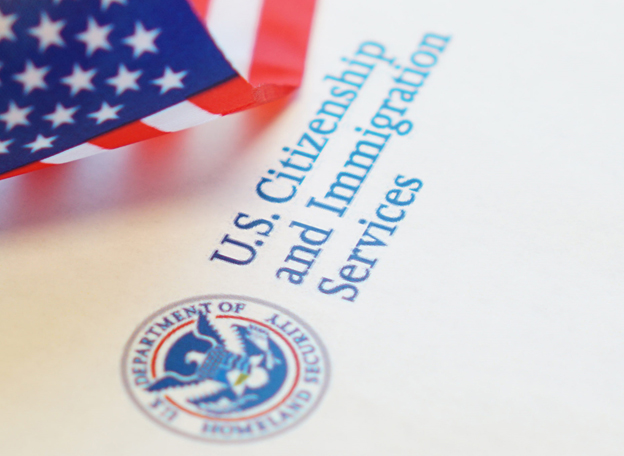Learn More About:
Immigration News & Updates eNewsletter ©  2011  - 2021Â
For questions about U.S. Residency, Green Cards and Immigration Visas, Visit our Website at: www.ImmigrateToday.com or  call our office at: (954) 382-5378
Check Out This Cool Stuff For Immigrants....
Immigration
Questions & Answers
This Week's Immigration NewsÂ
  Immigration News & Updates        Â
       Â
Immigration How To:
How Do I Know Whether I Need A Spouse or Fiancé Visa?
Questions About Immigration? We have the answers!
We Are Here To Help, Call us now for a FREE consultation (954) 382-5378
Is There A Secret Code Word For Getting Through
 To Live Person At USCIS 800#?
    AMERICAN IMMIGRATION
         LAW CENTERS
Immigration Questions: (954) 382-5378
 POSTING DATE: April 19, 2021
Question:Â I got my citizenship last year and filed for my mother who lives in Jamaica. I just had a baby and want her to come and visit me for a while. She has a tourist visa, but is worried that she wonât be able to come to the U.S. because I filed for her. Can you please tell us whether or not she can travel to the U.S. while her immigration case is pending?
American ImmigrationÂ
Law Center
2645 Executive Park DriveÂ
Suite 137
Weston, Florida 33331
Letâs face it, once Biden took office in January, he inherited a monumental disaster at the USCIS, resulting from Trump administration policies seemingly aimed at destroying our U.S. immigration system, coupled with the Covid-19 pandemic. Since that time, Biden has installed a new progressive pro-immigration director, issued numerous Executive Actions overturning Trump policies and begun rebuilding the agency. And slowly but surely things will improve, it just takes time to undo the damage and reconstitute operations.Â
However, one of the worst, yet least publicized measures taken by the Trump administration is implementation of the USCIS Interactive Voice Response Telephone System in mid-2020.Â
Helpful Immigration Tips You Can Use...
Tips On Automatic Citizenship Through A Parent
Most U.S. Residents have to wait for nearly five years before being eligible to apply for U.S. Citizenship (except spouses of U.S. Citizens, who must wait for only nearly three years). Thankfully, there is a special provision of the law which allows certain children to become U.S. Citizens automatically, as long as they meet strict legal criteria. Under the Child Citizenship Act of 2000, U.S. Resident children who are under age 18, automatically obtain U.S. Citizenship when a biological parent Naturalizes.Â
Answer:Â Immigration rules do not prevent your mother from using her valid B-2 tourist visa to visit you in the U.S., as long as she only intends to come and visit and not immigrate here at the time she enters the U.S.. However, as with all cases, officers at the airport can deny her entry if they believe she is coming with the intent to stay in the U.S. and immigrate. But the chance of that is very small. So, its likely safe for your mother to come and visit you and if she is questioned by the CBP officers as to why she is coming she should state the truth and make sure and say that she intends to leave the U.S. in several months and will process for your immigrant visa at the U.S. Consulate in Kingston.
President Biden recently terminated Trumpâs Public Charge policy, which had required residency applicants to submit form I-944 when filing form   I-485 and added public charge questions to other non-immigrant forms. As a result, most immigration forms which referred to the policy and required additional information for eligibility under the rule had to be updated by the Biden administration to remove those requirements.Â
The new forms are required for applications received by the USCIS on or after April 19, 2021. Applications filed on the old form which are received by the USCIS after that date will be rejected.Â
Hereâs a list of some of the most common forms which are required to be used beginning April 19, 2021:
Important Differences Between Spousal And Fiancé Visas
There is often a lot of confusion and misinformation about the differences between spousal and fiancé visas, which is best and who is eligible? Hereâs a quick rundown:
Visa Fiancé Visa:
The K-1 Visa Fiancé Visa is used by U.S. Citizens to bring a foreign fiancé to the U.S. in order to get married within 90 days and file for residency to get a Green Card.Â
Update: New Immigration Forms Versions Required Beginning April 19th
Millions of family members, workers and other visa applicants continue to be stranded outside the U.S., waiting for visa appointments in order to obtain visas to enter the U.S.. The existing visa backlog began to multiply each month after the pandemic hit in March, then continued once Trump issued immigration bans preventing immigrants from obtaining visas to enter the U.S..Â
And while President Joe Biden has reversed the bans, the consequences of Trumpâs anti-immigration policies and restrictive measures, coupled with the pandemic have resulted in a continuing backlog of some 2.6 million visa applications.
Visa Applicants Remain Stranded AbroadÂ
As Backlogs Grow To Over 2.6 Million
This new system has nearly eliminated the ability of callers to speak with a live agent at the USCIS. Itâs essentially a virtual âwallâ between immigrants and the USCIS. For those unfamiliar with the system, after dialing the 800#, one can spend hours calling and recalling the USCIS in frustration and despair, forced to answer questions from the automated attendant, only to have the attendant say âit looks like I canât help you, so I will end the callâ. When customers call with problems and need to speak to a human in order to resolve the issue, the logical response when queried by the automated attendant would be to ask to speak with an agent or representative, of course instead, this is a dead end which will eventually lead to the call being automatically terminated.
But donât worry, at least for now, there is a quick way to bypass the automated system and speak to a live agent. To get there, dial the USCIS at: 800-375-5283, choose English or Spanish, when the automated attendant asks you what you are calling about, just say "technical support" and then choose the second option.
My sincere hope is that the Biden administration will terminate this disastrous Interactive Voice Response Telephone System and go back to the old automated system which let you speak to a representative fairly easily. But for now, you know the secret code word, good luck!
Form I-485Â Application to Register Permanent Residence or Adjust Status
Form I-864Â Affidavit of Support Under Section 213A of the INA
Form I-864EZÂ Affidavit of Support Under Section 213A of the Act
Form I-864AÂ Contract Between Sponsor and Household Member
Form I-864WÂ Request for Exemption for Intending Immigrant's Affidavit of Support
Form I-539Â Application To Extend/Change Nonimmigrant Status
Visit the USCIS Forms Updates page
According to reports, nearly 500,000 of these applicants have already been prequalified (âdocumentarily qualified") by the National Visa Center and are just waiting to receive the required interview at the U.S. Consulate abroad and visa issuance so they can travel to the U.S.. However, since the pandemic hit, the majority of U.S. Embassies world-wide have not been in full operations, with some only providing emergency services on a case-by-case basis. Each day that goes by, thousands more cases including those of spouses, parents and children go into the endless waiting queue, resulting in millions of family members continuing to be separated.Â
Itâs important to understand that the current backlog is not just a consequence of the pandemic or the immigration bans, but rather the result of Trumpâs systemic, anti-immigrant policies executed through the USCIS and State Department over the past four years, which were implemented on day one of the Trump administration. The USCIS lost funding and reduced staff, which in turn took more processing time and issued fewer approvals, then the State Department cut personnel at consulates and processed visa applications slower, causing a growing backlog and further applied restrictive policies against applicants which resulted in even fewer visa approvals.
In response to reports about the massive backlog, the State Department recently told CNN that due to embassy and consular closures caused by the pandemic, they do not expect consular operations to return to pre-pandemic workload levels until June 2021 at the earliest. This means that the hundreds of thousands of visa interviews which were scheduled last year, then cancelled due to Covid-19 and various Trump bans will only start to be rescheduled in June, leaving hundreds of thousands of visa applicants who are waiting for their first appointment to wait for perhaps a year or more. To solve the crisis, Congress may pass funding to enable the State Department to hire thousands of new consular officers in an attempt to stem the backlog, but for now the multiplying backlog continues, with no end in sight. Stay tunedâ¦
Question:Â I came to the US back in 2016 on a work visa and me my American husband met and started dating. We got married in 2017 and I got my residency in 2018. I have a son back home but he wanted to stay and live with his father. Now he will be 20 next month and is interested in coming up and living with me here in the US. He has met my husband a few times and they get a long so we were thinking he could come and go to college here. We are not sure if it should be me to file his papers or my husband who is American. Can you please tell us which is better and if you can take our case? Thanks.
Answer:Â Good question. Immigration regulations allow both U.S. resident and citizen parents and step parents to sponsor their children to immigrate to the U.S. Itâs usually always best to have the U.S. citizen step-parent sponsor the minor child if possible, since once the petition is filed, the childâs age becomes âfixedâ under age 21, no matter how old the child is once they actually immigrate. The situation is totally different for a resident parent sponsoring a child, since the child continues to âageâ during the process and once the child reaches age 21, he or she may âage outâ and become an adult, which results in the child having to wait five or more years to immigrate. A minor child, under age 21, pre pandemic, would normally have immigrated here fairly quickly, within about a year or so. However due to USCIS processing times and visa backlogs it will now likely take several years if he is going through consular processing abroad. In that case, if you file for him as a U.S. resident, due to delays in consular processing, he may age out and not be able to immigrate as a minor child. To qualify as a step-parent, the childâs biological parent and step-parent much have been married before the child reached the age of 18. The law does not require the step-parent to legally adopt the child in order to qualify. Since you got married in 2017, your son was still under age 18, so your husband qualifies as his step-father and can sponsor him. We can get started on his case whenever you are ready.
Similarly, children of U.S. Citizens who immigrate to the U.S. from abroad and enter the U.S. before turning age 18, become automatic U.S. Citizens as well. Qualifying children must be under age 18 at the time their parent actually naturalizes (takes the Oath), not the date the parent files for Naturalization.Â
As a result, parents should carefully plan the date of filing for Naturalization to ensure that they will complete the process before their child(ren) reach age 18. Figuring 8 months to take into account any USCIS processing delays is reasonable, although most naturalization cases are completed within 4 months or so. Importantly, even when children become U.S. Citizens through this process, the USCIS does not automatically issue a Naturalization Certificate. However, in reality, none is required, since applying for a U.S. Passport is all that is necessary to prove the childâs new U.S. Citizenship status.â¯In such cases, in addition to other information, the U.S. Passport office requires a copy of the parentsâ Naturalization Certificate in order to demonstrate the childâs eligibility as a U.S. Citizen to obtain a U.S. Passport. If you do desire to have the actual Certificate of Citizenship, you will need to file form N-600 and pay the USCIS filing of $1,170, along with supporting documentation to prove automatic citizenship. Current processing time can take anywhere from 6 to 12 months or more.
From that point, the residency process can take another year or so for the foreign spouse to actually receive his or her green card. Importantly, U.S. residents, Green Card holders cannot file for a fiancé visa, only U.S. citizens can. The process for the fiancée visa alone can take up to ten months for the K-1 interview at the U.S. consulate due to Covid-19 related delays. Then another year for the actual residency process inside the U.S..
Spousal visa:
A Spousal visa is used by both U.S. Citizens and U.S. Residents to bring a foreign spouse to the U.S. as a U.S. Resident, without the need to file for residency once they arrive in the U.S.. Spouses actually obtain U.S. Residency the moment they enter the U.S. at the airport or port of entry, and border officials review their immigrant visa documents and put an order in the USCIS system for production of the new residentâs Green Card right then and there upon their arrival. They usually receive their actual Green Card in about 30-60 days or so after entering the U.S.. Once a foreign spouse has been a resident for at least two years and nine months, he or she is eligible to file for early naturalization.
So which route is better? Is it best to bring a fiancé to the U.S. and file for residency or just get married and bring your spouse to the U.S. as a resident? Well, in the old days, the fiancé visa process was pretty quick, about three months for approval, then a quick interview at the consulate abroad and once the couple got married and filed for the new spouseâs residency, he or she could get their Green Card in as little as six months or so. But these days, the fiancé visa process can take upwards of eight months or more to be approved, then another few months to get the interview at the consulate abroad. Then once the fiancé comes to the U.S. and the couple marries, another possible year to get a Green Card, so that is about two years or so for the process. Contrast that with a spousal case, where the U.S. Citizen and foreign spouse get married and once the immigration petition is filed, it takes about eight â twelve months for approval and another two to four months for a consular interview, where the foreign spouse is issued an immigrant visa, which automatically converts to residency (Green Card) once he or she enters the U.S.. So the entire spousal process takes about twelve to fourteen months or so, in contrast with the fiancé process which can take upwards of two years all together to get the Green Card.
Given the current timing, spousal visas are much faster and more efficient these days. The only time that a fiancé visa would normally be in order, is when the foreign fiancé has minor children who are over age 18 and still under age 21. Itâs a really strange and wonderful fluke in the law. For background, under the âImmediate Relativeâ law, a minor child of foreign spouse qualifies as a âStep-childâ which can be sponsored by the U.S. Citizen or Resident, as long as the marriage to the childâs parent took place before the child turned age 18. One day over age 18 and the child loses the ability to obtain Residency from the Stepparent. But, under the fiancé visa (K-1), minor children of the fiancé, under age 21 are eligible to be issued a K-2 Visa, which allows them to accompany their parent to the U.S. up until they reach age 21 and obtain a Green Card along with the parent. In this case, there is no requirement that their parent and step parent marry before the child reaches age 18! Strange, but true!Â
The most common case would involve a foreign fiancé whose children are age 19 or younger. A 20 year old child may still have a chance, as long as the child only recently turned age 20, given the time required for the fiancé visa to be approved and the consular interview to be scheduled for the fiancé and his or her children. As long as the visas are issued and the K-2 children enter the U.S. before they turn age 21, they remain eligible for residency. One day over age 21 and they become ineligible.
As you can see, when minor children are involved, itâs crucial that parents preplan the immigration process very carefully to ensure that children are able to immigrate to the U.S. along with their parent. Once a child turns age 21 (called âaging outâ), they fall into an immigration category called F1 (for single children of U.S. Citizens) and F2B (for single children of U.S. Residents), which then takes 5 years waiting time for them to be able to immigrate to the U.S.. That is like an eternity for a family and very tragic indeed.Â













